Assessing the Impacts of the Israeli–Palestinian Conflict on Global Sea Transportation: From the View of Mass Tanker Trajectories
Abstract
1. Introduction
2. Related Works
2.1. Analysis of Global Shipping Under the Impact of Emergencies
2.2. Analysis of Data-Driven Sea Transportation Situation
3. Methodology for Processing Trajectory Data of Oil Tankers
3.1. Data Preprocessing
3.1.1. Data Compression
3.1.2. Data Cleaning
3.1.3. Data Mapping
3.1.4. Abnormal Data Processing
3.2. Vessel Trajectory Generation Based on DBScan Algorithm
4. Methodology for Analyzing Transportation Situation of Oil Tankers
4.1. Analysis of Changes in Shipping Cost
4.2. Shipping Cost Increment Index for Various Countries
4.3. Analysis of Global Tanker Flow
5. Analysis of Results
5.1. Changes in Shipping Costs of Tankers
5.2. Changes in Sea Traffic Flow
6. Discussion and Conclusions
Author Contributions
Funding
Institutional Review Board Statement
Informed Consent Statement
Data Availability Statement
Conflicts of Interest
References
- Wang, C.; Kim, Y.S.; Kim, C.Y. Causality between logistics infrastructure and economic development in china. Transp. Policy 2021, 100, 49–58. [Google Scholar] [CrossRef]
- Cariou, P.; Lindstad, E.; Jia, H. The impact of an eu maritime emissions trading system on oil trades. Transp. Res. Part D Transp. Environ. 2021, 99, 102992. [Google Scholar] [CrossRef]
- Lagouvardou, S.; Psaraftis, H. Implications of the eu emissions trading system (ets) on european container routes: A carbon leakage case study. Marit. Transp. Res. 2022, 3, 100059. [Google Scholar] [CrossRef]
- Kotzampasakis, M. Intercontinental shipping in the european union emissions trading system: A ‘fifty-fifty’ alignment with the law of the sea and international climate law? Rev. Eur. Comp. Int. Environ. Law 2023, 32, 29–43. [Google Scholar] [CrossRef]
- Keppler, N. Russian invasion left mariners in harm’s way, stressed supply chains. Prof. Mar. J. Marit. Ind. 2022, 38–41. Available online: https://professionalmariner.com/article/russian-invasion-left-mariners-in-harms-way-stressed-supply-chains/ (accessed on 20 May 2024).
- Li, B.; Lu, J.; Li, J. Evaluation of Emergency Guarantee Capability of Key Nodes in Maritime Transport Based on Improved Copula Function. J. Transp. Syst. Eng. Inf. Technol. 2020, 20, 20–25. [Google Scholar]
- Tang, Y.S.; Yu, G.Q.; Liu, S.X. Reshaping the global security order and China’s security governance in the Middle East. West Asia Afr. 2024, 4, 3-26159. [Google Scholar]
- Shu, X.L.; Zou, J.T. Implications of the Israeli-Palestinian conflict for the Middle East and international energy security. Technol. Econ. Petrochem. 2024, 40, 1–5. [Google Scholar]
- Wang, L.C.; Li, S.X.; Gao, Z.G. The Israeli-Palestinian conflict: Causes, Effects, and Solutions. Int. Econ. Rev. 2024, 1, 1–22. [Google Scholar]
- Cho, J.; Hong, E.K.; Yoo, J.; Cheong, I. The impact of global protectionism on port logistics demand. Sustainability 2020, 12, 1444. [Google Scholar] [CrossRef]
- Ilyas, M.; Jin, Z.; Ullah, I.; Abbas, A.J. Investigation of Risk Factors Influencing the Safety of Maritime Containers Supply Chain: In the Period of the Pandemic. Sustainability 2023, 15, 8803. [Google Scholar] [CrossRef]
- Shepard, J.U.; Pratson, L.F. Maritime piracy in the strait of hormuz and implications of energy export security. Energy Policy 2020, 140, 111379. [Google Scholar] [CrossRef]
- Steinbach, S. The Russia-Ukraine war and global trade reallocations. Econ. Lett. 2023, 226, 111075. [Google Scholar] [CrossRef]
- Yang, Y.; Sun, L. Vulnerability analysis of maritime silk road shipping network under port emergencies. Int. J. Shipp. Transp. Logist. 2023, 18, 364–382. [Google Scholar] [CrossRef]
- To, W.M.; Lee, P.K.C. The COVID-19 impacts on air transport—A case study of Hong Kong. Int. J. Shipp. Transp. Logist. IJSTL 2023, 16, 256–276. [Google Scholar] [CrossRef]
- Sercan, E. The early impact of the Russia-Ukraine war on seaborne trade and transportation in the Black Sea. Int. J. Shipp. Transp. Logist. IJSTL 2024, 18, 305–323. [Google Scholar]
- Fang, Z.; Yu, H.; Lu, F.; Feng, M.; Huang, M. Maritime network dynamics before and after international events. Acta Geogr. Sin. 2018, 28, 20. [Google Scholar] [CrossRef]
- Peng, P.; Poon, J.P.; Cheng, S.; Dong, Y.; Yang, Y.; Lu, F. Container port influence: A spatial diffusion analysis of global transshipments. Marit. Policy Manag. 2023, 1–18. [Google Scholar] [CrossRef]
- Zaman, M.B.; Kobayashi, E.; Wakabayashi, N.; Maimun, A. Risk of navigation for marine traffic in the malacca strait using AIS. Procedia Earth Planet. Sci. 2015, 14, 33–40. [Google Scholar] [CrossRef]
- Fan, H.W.; Chang, Z.; Wang, C. Influencing factors and evaluation of safety resilience of key nodes in maritime transportation channels. J. Shanghai Marit. Univ. 2022, 43, 40–46. [Google Scholar]
- Chu, H.C. Crude oil prices, container freight rates and dry bulk freight rates: Are there short-term and long-term effects on seaborne exports from taiwan? Int. J. Shipp. Transp. Logist. IJSTL 2023, 17, 451–468. [Google Scholar]
- Xiao, Z.; Fu, X.; Zhang, L.; Goh, R.S.M. Traffic pattern mining and forecasting technologies in maritime traffic service networks: A comprehensive survey. IEEE Trans. Intell. Transp. Syst. 2020, 21, 1796–1825. [Google Scholar] [CrossRef]
- Varlamis, I.; Kontopoulos, I.; Tserpes, K.; Etemad, M.; Soares, A.; Matwin, S. Building navigation networks from multi-vessel trajectory data. Geoinformatica 2021, 25, 69–97. [Google Scholar] [CrossRef]
- Zhang, Y.Q.; Shi, G.Y.; Li, S. Compression algorithm of ship trajectory based on online directed acyclic graph. J. Traffic Transp. Eng. 2020, 20, 227–236. [Google Scholar]
- Wu, L.; Xu, Y.; Wang, Q.; Wang, F.; Xu, Z. Mapping Global Shipping Density from AIS Data. J. Navig. 2017, 70, 67–81. [Google Scholar] [CrossRef]
- Han, P.; Yang, X. Big data-driven automatic generation of ship route planning in complex maritime environments. Acta Oceanol. Sin. Engl. Ed. 2020, 39, 113–120. [Google Scholar] [CrossRef]
- Xiao, F.; Ligteringen, H.; Gulijk, C.V.; Ale, B. Comparison study on ais data of ship traffic behavior. Ocean Eng. 2015, 95, 84–93. [Google Scholar] [CrossRef]
- Liu, B.; Souza, E.N.D.; Matwin, S.; Sydow, M. Knowledge-based clustering of ship trajectories using density-based approach. In Proceedings of the 2014 IEEE International Conference on Big Data (Big Data), Washington, DC, USA, 27–30 October 2014. [Google Scholar]
- Ng, H.K.; Chen, N.Y. Aircraft trajectory optimization and contrails avoidance in the presence of winds. J. Guid. Control Dyn. 2010, 34, 1577–1583. [Google Scholar]
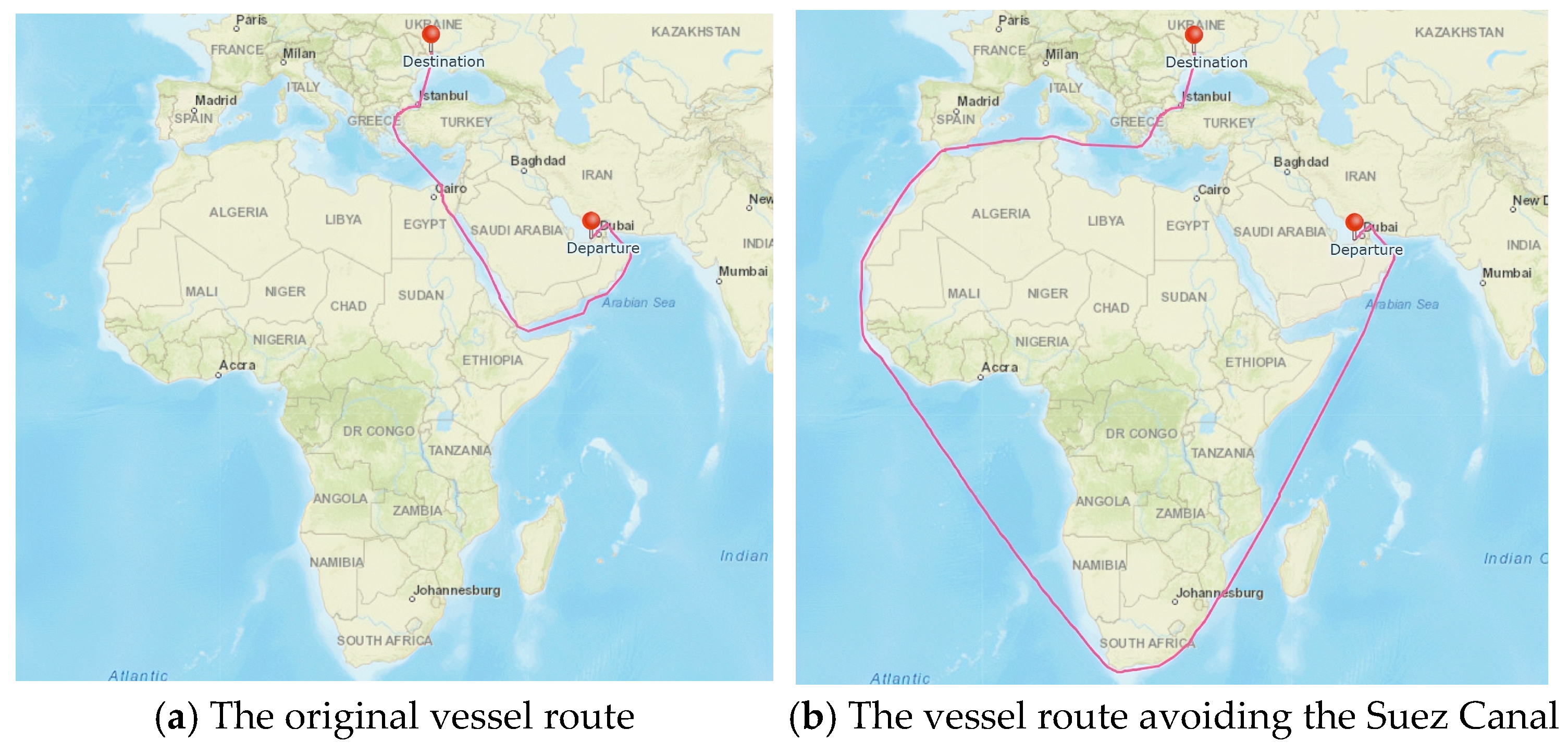
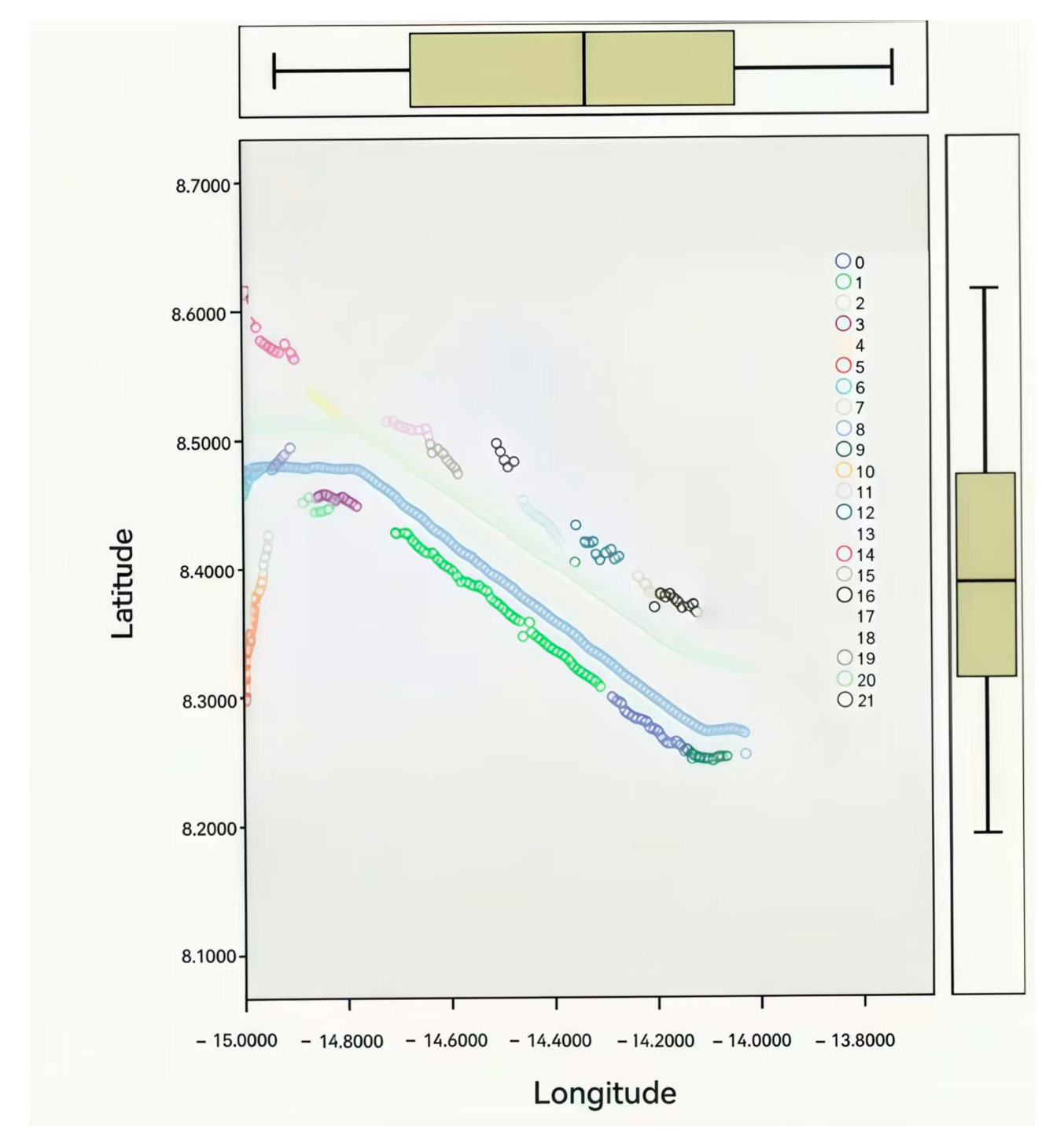
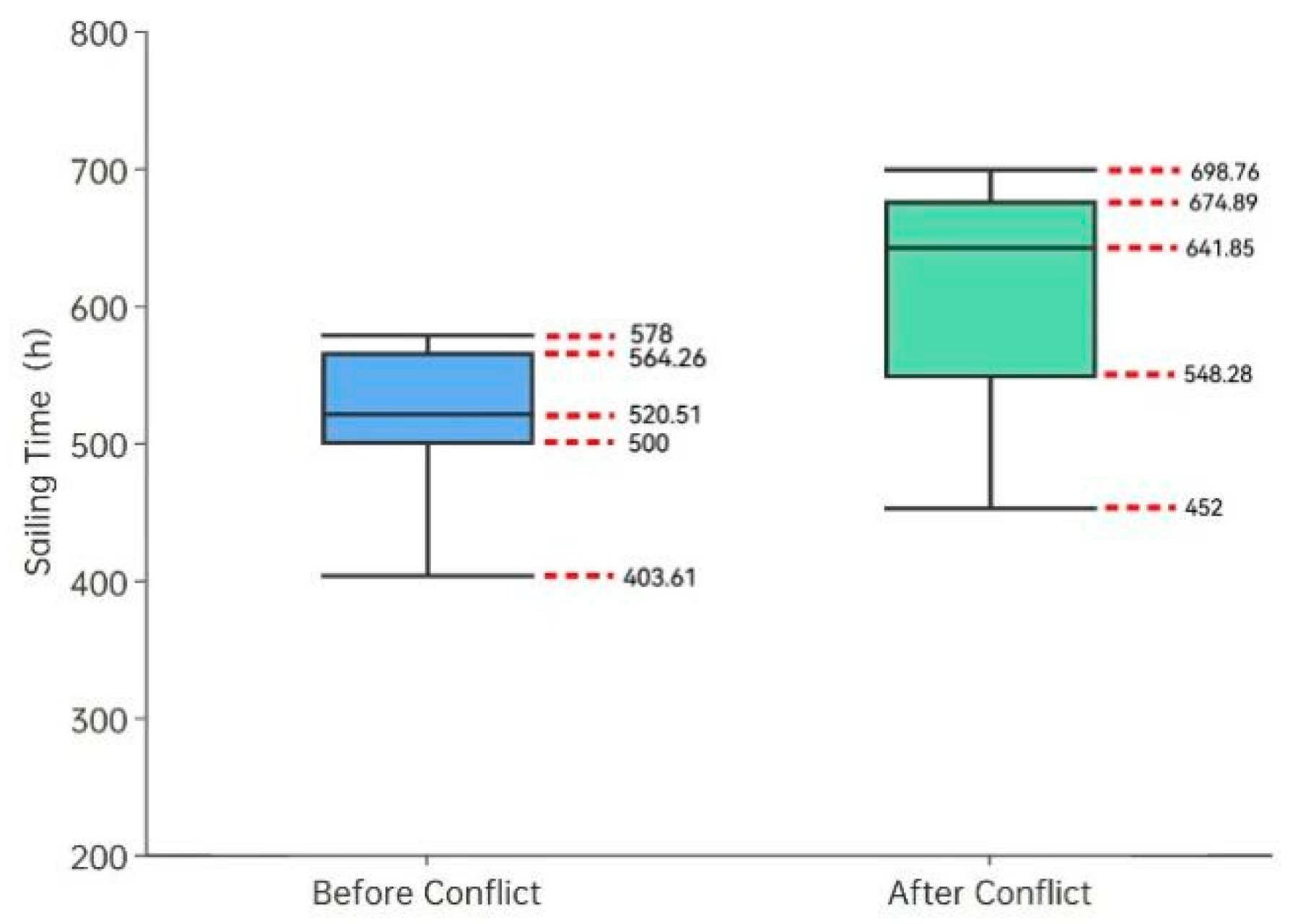

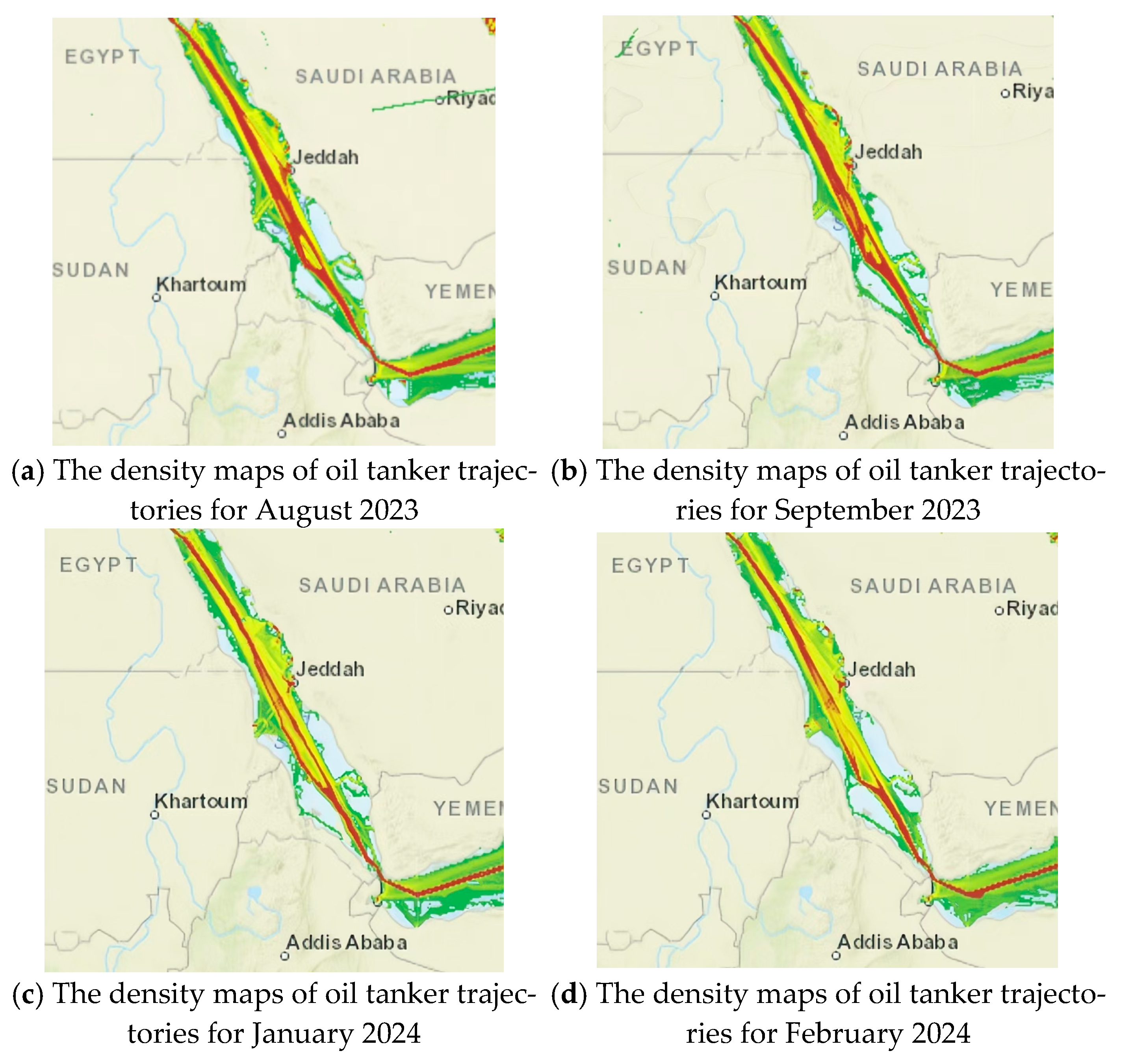
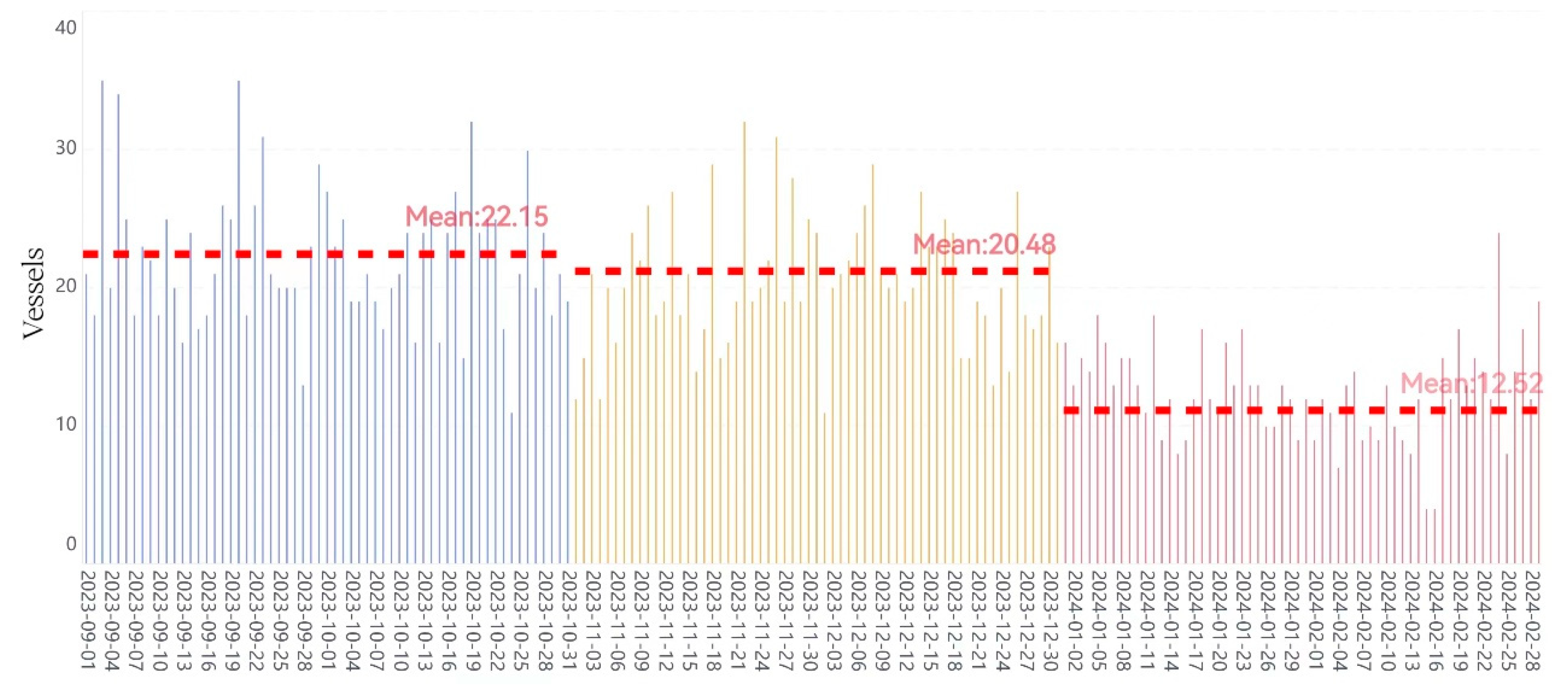
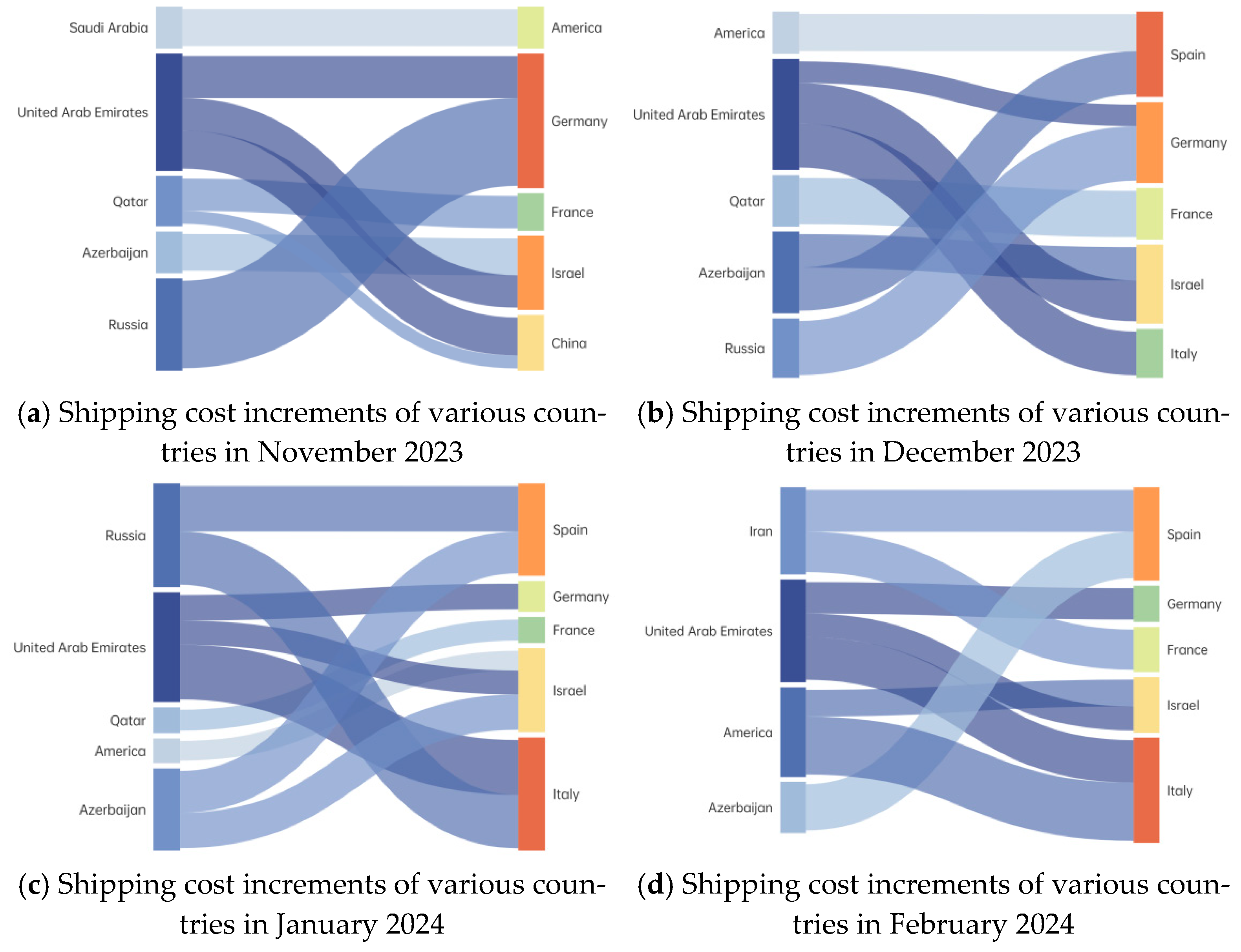
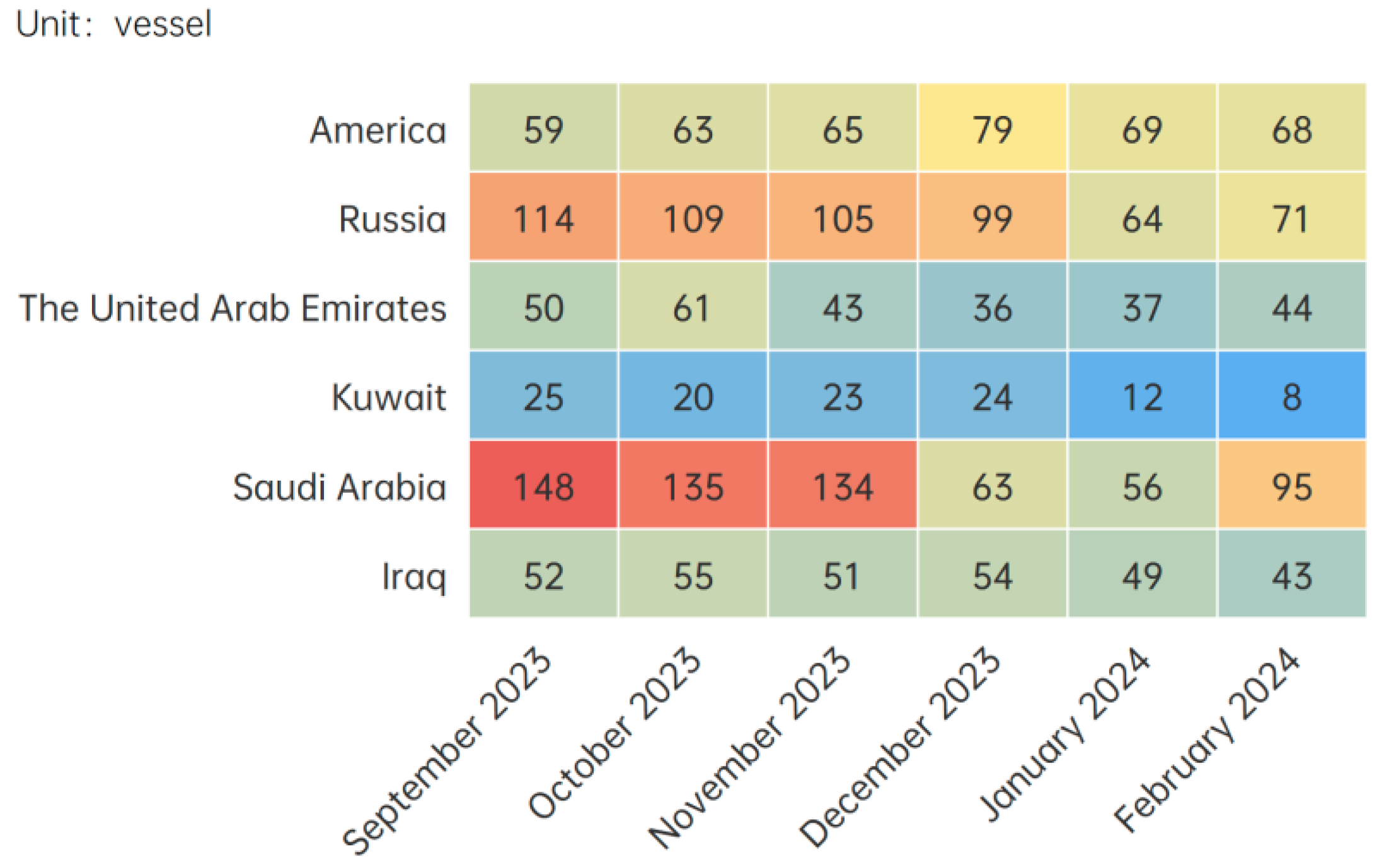
| Field | Description |
|---|---|
| MMSI | Maritime mobile service identity |
| receive_time | Time stamp (unit: second) |
| nav_status | Vessel status |
| rot | Rate of turn |
| sog | Speed over ground |
| eta | Estimated time of arrival |
| dest | Destination |
| lon | Longitude (range: −180 to 180) |
| lat | Latitude (range: −90 to 90) |
| cog | Course over ground |
| DT_Pos_Utc | AIS dynamic position update time |
| Field | Description |
|---|---|
| MMSI | Maritime mobile service identity |
| receive_time | Time stamp (unit: second) |
| name | Name of vessel |
| callsign | Call sign of vessel |
| vessel_type | Type of vessel |
| draught | Vessel draught |
| dsource | Data source |
| Country | Shipping Cost Increment (Hour/Month) | Proportion of Detour Vessels (%) |
|---|---|---|
| Germany | 963.03 | 0.205 |
| France | 752.16 | 0.173 |
| Israel | 385.3 | 0.067 |
| Spain | 262.5 | 0.052 |
| The United States | 153.8 | 0.04 |
Disclaimer/Publisher’s Note: The statements, opinions and data contained in all publications are solely those of the individual author(s) and contributor(s) and not of MDPI and/or the editor(s). MDPI and/or the editor(s) disclaim responsibility for any injury to people or property resulting from any ideas, methods, instructions or products referred to in the content. |
© 2025 by the authors. Licensee MDPI, Basel, Switzerland. This article is an open access article distributed under the terms and conditions of the Creative Commons Attribution (CC BY) license (https://creativecommons.org/licenses/by/4.0/).
Share and Cite
Zhang, B.; Chen, X.; Liu, H.; Ye, L.; Zhang, R.; Zhao, Y. Assessing the Impacts of the Israeli–Palestinian Conflict on Global Sea Transportation: From the View of Mass Tanker Trajectories. J. Mar. Sci. Eng. 2025, 13, 311. https://doi.org/10.3390/jmse13020311
Zhang B, Chen X, Liu H, Ye L, Zhang R, Zhao Y. Assessing the Impacts of the Israeli–Palestinian Conflict on Global Sea Transportation: From the View of Mass Tanker Trajectories. Journal of Marine Science and Engineering. 2025; 13(2):311. https://doi.org/10.3390/jmse13020311
Chicago/Turabian StyleZhang, Bing, Xiaohui Chen, Haiyan Liu, Lin Ye, Ran Zhang, and Yunpeng Zhao. 2025. "Assessing the Impacts of the Israeli–Palestinian Conflict on Global Sea Transportation: From the View of Mass Tanker Trajectories" Journal of Marine Science and Engineering 13, no. 2: 311. https://doi.org/10.3390/jmse13020311
APA StyleZhang, B., Chen, X., Liu, H., Ye, L., Zhang, R., & Zhao, Y. (2025). Assessing the Impacts of the Israeli–Palestinian Conflict on Global Sea Transportation: From the View of Mass Tanker Trajectories. Journal of Marine Science and Engineering, 13(2), 311. https://doi.org/10.3390/jmse13020311






